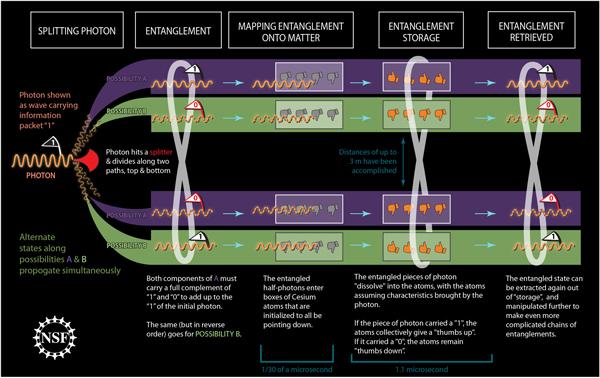Researchers Use Quantum Entanglement to Create Wireless, “Invisible” Speakers

For the layman, “quantum entanglement” refers to a hard-to-believe aspect of quantum mechanics that allows two particles to be linked, or “entangled”, in such a way that, even though they might be separated half-way across the universe, something that happens to one of the particles instantaneously affects the other particle. (Confused? Watch the six-minute-long video below. It does a nice job explaining quantum entanglement, but I think even Einstein would find the animated presenters more spooky than the topic itself.)
The LRPA team’s new technology, dubbed Frequency Regeneration by Exact Acoustic Quantum Entanglement (FREAQE, pronounced “freak-ee”), quantumly entangles the layer of particles immediately in front of a loudspeaker’s drivers with a layer of air particles precisely located in front of a distant listener, causing a sound pressure wave identical to the one created by the speaker to be generated in the listening room. In other words, when the speaker’s drivers move – making the air in front of them to move and then push or pull successive layers of air – the remote layer of quantum-entangled air moves, too, generating an exact analog of sound waves in the listening room. Although the initial prototype device used to generate the entanglement is extremely large and requires a significant amount of electricity to operate, the results so far are astounding. In fact, the sound quality in the remote room is often better than that from the speakers, themselves.
“The dispersion of virtually all loudspeakers is affected by the presence of the front baffle,” the LRPA facility’s director, Dr. F. Fourier said. “Because our technique produces sound without the physical presence of the speaker, there is no speaker baffle in the room to affect the entangled sound waves as they move forward. Audiophiles, such as myself, often describe great sounding speakers as seeming to ‘disappear’. FREAQE literally makes the speakers disappear, both visually and acoustically. And despite the association with the word ‘quantum’, there is no quantization – or sampling - in the traditional sense. It’s really an analog process of recreating sound.”
Dr. Fourier attributes his keen interest in acoustics to the many arguments his parents had over his father’s hi-fi system. “Dad had a pair of huge Polk SDA SRS loudspeakers, and Mom was always tripping over the damn interconnect cable between them, not to mention the long runs of thick Monster Cable running from the amps. I think what finally caused them to divorce was the fact that Dad never let anyone sit in the sweet spot on the couch. He wouldn’t let Mom or me ever touch the remote control, either.”
Of course, FREAQE technology doesn’t eliminate speakers altogether. It does, however, allow you to put the speakers wherever you want to. “You can put them in a basement, a garage, a barn… It doesn’t matter. The only requirement is that they be hooked up to an amplifier and are capable of producing sound,” observed Fourier. You’ll also need room for the FREAQE device, which, at the moment, is prohibitively expensive for use in most people’s home theaters. However, Fourier thinks that within eight-to-ten years the price for a FREAQE device capable of handling 5.1 channels could be under $200. For someone who has a traditional LCR setup in the front but needs invisible – and wireless – surround speakers, a simpler two-channel FREAQE component would be even cheaper. “I’d like to think that we could get the price for a single-channel FREAQE invisible subwoofer device under fifty bucks. And once the technology becomes that affordable, we’ll also be able to use FREAQE to make wireless, invisible earbuds that will be totally comfortable to wear because you won’t actually be wearing them!”
While Fourier works on perfecting FREAQE for sound, he also has his eye on another prize – an invisible television, using a related technology that a member of his team at LRPA, Dr. Hugh V. Reyes, dubbed Linear Optical Organizing Function (LOOF). “In theory,” Reyes said, “we ought to be able to entangle the photons in front of a projection screen with photons in front of a distant viewer and create a LOOF big screen in front of him. Similar to what happens with FREAQE and speaker baffles, a LOOF TV image wouldn’t be affected by the reflection of ambient room light off the (nonexistent) screen.”
As with any new technology, there are still multiple hurdles before the LRPA team’s FREAQE and LOOF developments become ready for sale to the general public. Initial cost of the equipment, size, and energy costs of running the devices are obviously the biggest barriers. Ethical issues, however, regarding limitations on where the entangled particles can be located also need to be addressed. Fourier notes that while it might seem funny to cause a big screen image of a porn star to appear in a friend’s living room while his minister is over for dinner, it’s an entirely different thing to create mysterious noises in an annoying neighbor’s home in order to make them move because they think the house is haunted. And inducing schizophrenic-like symptoms by generating disembodied voices in an unsuspecting person’s ear canals could have lethal consequences.
Fourier and Reyes seem unfazed by the potential downsides. “It’s really more of a legal issue than a technological one. I’m sure the legislatures will be able to work it out,” Fourier noted. “I suppose there might be some free speech rights that might be affected, though.”
Floating X-rated images, ghostly voices, and sounds that go bump in the night – maybe Einstein’s “spooky action” description was truer than he thought. It certainly seems too good to be true, but maybe we’re just being foolish.
(Image Courtesy: National Science Foundation)













































